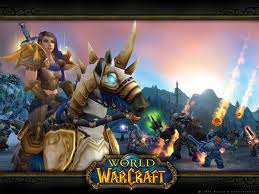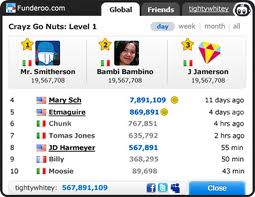Category Archives: Social Gaming
Applying Gamification in the Workplace
Posted by Hindol Datta
Wikipedia defines gamification as the use of game mechanics and game design techniques in non-game contexts. It applies to non-game applications and processes, in order to encourage people to adopt them, or to influence how they are used. It makes technology use more exciting and engaging, and encourages users to engage in desired behaviors with fruitful consequences to the environment where these techniques and processes are being deployed.
Many years ago, I took a series of courses at Cal Tech in Pasadena at the School of Industrial Relations. One of the courses was applying tools to encourage teamwork and participation. Thereafter, I have attended field trips in organizations in strategic off-sites where we had to do rope walking, free fall, climbing bamboo structures strung together to retrieve flags, etc. Thus, in those days – we applied sports and board games to fuel a shared success environment. Now things have become more technology oriented, and we have thus seamlessly transitioned to some extent from those environments to consumer web based experiences. This does not suggest that the other alternatives are less rewarding; they draw upon other types of triggers but gamification through technology is more accessible and generally less expensive with less overhead in the long run.
What are the four key elements in Gamification?
Games generally tend to have four elements that are closely intertwined. Absent any of these four elements and the jury would be out on whether the application could suitably be considered gamified. Clearly, when these elements are being applied to non-gaming contexts, you will find that some of these elements are more watered down or cruder representation of game design principles or applications to actual game play environments. Regardless, all of these elements are necessary conditions that must come into play.
1.Narratives
Games have narratives. They must be able to tell a story. They must place the player or user in a context, make them aware of the context, create a temporal dimension of a past, present and future and provide a theme or a set of themes that the players pursue.
2.Game Mechanics
These constitute the provision of tools and use cases that create PvP (Player vs. Player) or PvE (Player vs. Environment) experience. Common tools like teleporting, cockpit load (number of player controls), in-game user interaction, human-computer interaction, etc. come into play. The mechanics must aptly support the narrative.
3.Aesthetics
People look for rich experiences. In MMORPG, the aesthetics are extremely rich and immersive. In gamified applications, it need not be so. Regardless, users have continued to raise the bar on aesthetics and richness of media to support their interaction. So the trend toward aesthetics will continue, albeit at a lower benchmark than would be in the extreme case of a high quality MMORPG game.
4.Rewards
Finally, games have to have a purpose. The narratives have to have a light at the end of the tunnel. There is a carrot and stick principle in game design. It is a very important component to either persuade people to behave or not behave in a certain manner. Rewards are vanity points awarded for achieving goals that are user-driven or context driven. Either way, it is and will continue to remain the key element in game design.
The myth of rewards!
In one my earlier blogs, I laid out the distinction between intrinsic and extrinsic motivation. This has bearing on the concept of rewards and recognition in the workplace. You can find the details in my blog – “Intrinsic and Extrinsic Motivation: Impact on Employee Engagement”. (https://linkedstarsblog.com/2012/10/16/intrinsic-and-extrinsic-motivation-impact-on-employee-engagement/
Designing an application with rewards to fuel engagement in the workplace is a good idea. But rewards have to follow a narrative, a storyline. For example, an application that simply awards points and badges based on transactions without a narrative cannot be considered an application that applies all of the elements of the gamification process. It only addresses one element, and in fact, for some it is the least important component. When one focuses the product design around this single component, I contend that you are not really gamifying; you are in fact drawing upon some temporary impulses that are not sustainable and enduring.
Hence, the narrative and craftsmanship is quite critical to gamifying an application and making it relevant for employees in the workplace.
One must adopt the right mix of the gaming elements to ultimately create ends such as stickiness, re-engagement, and deeper levels of interaction, fun, challenge, promoting options to cooperate and also compete, and broadcast success.
Scales:
So now we arrive at assessing the scales to benchmark each of those ends. I am being particular by not calling these tools, since tools are to support mechanics whereas scales are manifestations of an end result. For practical design and implementation purposes, here are a few scales that are common across all games, some of which are quite relevant for gamification in an employee setting. Some of the more common scales to assess or broadcast success are:
1) Leaderboards
2) Achievement levels and measures of achievements
3) Challenges between users
4) Progress Bars
5) Reward Points that have redemption value
To reiterate, for the final outcomes associated with the scales to be meaningful, the narrative is extremely important. Storyboarding the experience in various settings is the key to designing relevant gamified applications. In fact, applying the appropriate narratives concerning particular industries is a very interesting architectural initiative that can be pursued.
Thus, in the case of workplace engagement, if the nuances of the work and the industry were emulated around themes with contextual narratives, it would truly make for wonderful experiences that ignite employee engagement while furthering corporate objectives.
Posted in Employee Engagement, Extrinsic Rewards, Gamification, Intrinsic Rewards, Product Design, Recognition, Rewards, Social Dynamics, Social Gaming
Tags: employee engagement, extrinsic motivation, game design, gamification, innovation, intrinsic motivation, leaderboards, product design, relevance, social network, social systems
Standing Ovation Problem and Product Design
Posted by Hindol Datta
When you seed another social network into an ecosystem, you are, for the lack of a better word, embracing the tenets of a standing ovation model. The standing ovation model has become, as of late, the fundamental rubric upon which several key principles associated with content, virality, emulation, cognitive psychology, location principles, social status and behavioral impulse coalesce together in various mixes to produce what would be the diffusion of the social network principles as it ripples through the population it contacts. Please keep in mind that this model provides the highest level perspective that fields the trajectory of the social network dynamics. There are however a number of other models that are more tactical and borrowed from the fields of epidemiology and growth economics that will address important elements like the tipping points that generally play a large role in essentially creating that critical mass of crowdswell, which once attained is difficult to reverse, unless of course there are legislative and technology reversals that may defeat the dynamics.
So I will focus, in this post, the importance of standing ovation model. The basic SOP (Standing Ovation problem) can be simply stated as: A lecture or content display in an audience ends and the audience starts to applaud. The applause builds and tentatively, a few audience may members may or may not decide to stand. This could be abstracted in our world as an audience that is a passive user versus an active user in the ecosystem. The question that emerges is whether a standing ovation ensues or does the enthusiasm fizzle. SOP problems were first studied by Schelling.
In the simplest form of the model, when a performance or content consumption ends, an audience member must decide whether or not to stand. Now if the decision to stand is made without any consideration of the dynamics of the other people in the audience, then there is no problem per se and the SOP model does not come into play. However, if the random person is on the fence or is reluctant or may not have enjoyed the content … would the behavioral and location dynamics of the other participants in the audience influence him enough to stand even against his better judgment. The latter case is an example of information cascade or what is often called the “following the herd” mentality which essentially means that the individuals abnegates his position in favor of the collective judgment of the people around him. So this model and its application to social networks is best explained by looking at the following elements:
1. Group Response: If you are part of a group and you have your set of judgments governing your decision to stand up, then are you willing to reserve those judgments to be part of group behavior. At what point is a person willing to seed doubt and play along with a larger response. This has important implications. For example, if you are in an audience and a member of a group that you know well, and a certain threshold quantity in the group responds favorably to the content, there may be some likelihood that you would follow along. On the other hand, if you are an individual in an audience, albeit not connected to a group, there is still some chance of you to follow along as long as it meets some threshold for example – if I can see about people stand, I will follow along. In a known group which may constitute you being a participant among five people, even if 3 people stand, you may stand up even though it does not meet your random 10 people formula. This has important implications in cohorts, building groups, providing tools and computational agents in social networks and dynamics to incline a passive consumer to an active consumer.
2. Visibility to the Group: Location is an important piece of the SOP. Imagine a theater. If you are the first one in the center of all rows, you will, unless you turn back, not be cognizant of people’s reactions. Thus, your response to the content will be preliminarily fed by the intensity of your reaction to the content. On the other hand, if you are seated behind, you will have a broader perspective and you may respond to the dynamics of how the others respond to the content. What does this mean in social dynamics and introducing more active participation? Simply that you have to again provide the underlying mechanisms that allow people to respond at a temporal level ( a short time frame) to how a threshold mass of people have responded. Affording that one person visibility that would follow up with a desired response would create the information cascade that would culminate in a large standing ovation.
3. Beachhead Response: An audience will have bias. That is another presumption in the model. They will carry certain judgments prior to a show – one of which is that the people in front who have bought the expensive seats are influential and have “celebrity” status. Now depending on the weight of this bias, a random person, in spite a positive audience response, may not respond positively if the front rows do not respond positively. Thus, he is heavily inclined to discounting the general audience threshold toward a threshold associated with a select group that could result in different behavior. However, it is also possible that if the beachhead responds positively and not the audience, the random person may react positively despite the general threshold dynamics. So the point being that designing and developing products in a social environment have to be able to measure such biases, see responses and then introduce computational agents to create fuller participation.
Thus, the SOP is the fundamental crux around which a product design has to be considered. In that, to the extent possible, you bring in a person who belongs to a group, has the spatial visibility, and responds accordingly would thus make for an enduring response to content. Of course, the content is a critical component as well for poor content, regardless of all ovation agents introduced, may not trigger a desired response. So content is as much an important pillar as is the placing of the random person with their thresholds of reaction. So build the content, design the audience, and design the placement of the random person in order that all three coalesce to make an active participant result out of a passive audience.
Posted in Leadership, Learning Organization, Organization Architecture, Ovation, Social Dynamics, Social Gaming, Social Network, Social Systems, Virality
Tags: applause, audience, copy, emulate, group, leadership, motivation, product design, recognition, social dynamics, social network, social networks, social normns, virality
Free, Freemium, Pay-to_Play: Business Model Implications
Posted by Hindol Datta
 “Free” has become ubiquitous in the digital age. It has been touted widely as the only mechanism which is a necessary condition or an iron law for providing digital products and services across the Internet. More exactly, there is an inexorable pressure upon price points on digital products whose marginal cost of production is minimal. So business models are cropping up and encouraging the consumers to chart an “Internet Consumer Bill of Rights”: the business models painfully and reluctantly argue that the consumers’ personal information is being exchanged to get these “free” products which can be monetized by advertisements and the like. However, these toutings and exclamations by the pundits of “Free” have adversely impacted many industries that have been forced to go along with it, absent any immediate choice in that matter. Read the rest of this entry →
“Free” has become ubiquitous in the digital age. It has been touted widely as the only mechanism which is a necessary condition or an iron law for providing digital products and services across the Internet. More exactly, there is an inexorable pressure upon price points on digital products whose marginal cost of production is minimal. So business models are cropping up and encouraging the consumers to chart an “Internet Consumer Bill of Rights”: the business models painfully and reluctantly argue that the consumers’ personal information is being exchanged to get these “free” products which can be monetized by advertisements and the like. However, these toutings and exclamations by the pundits of “Free” have adversely impacted many industries that have been forced to go along with it, absent any immediate choice in that matter. Read the rest of this entry →
Posted in Free, Freemium, Native Monetization, Pay-to-Play, Pricing, Risk Management, Social Gaming
Tags: brand, business model, chris anderson, curate, free, free to play, freemium, joker, paywall, price
Social Gaming and Organizational Psychology
Posted by Hindol Datta
 We encourage children to play. It is one of the oldest and cheapest forms of entertainment. Children create imaginary worlds, assume roles, establish rules, and determine what constitutes a win. In all that, along the way they create the processes that elevate fun and learning … though we, as adults, may have different opinions about the type of fun and the magnitude of learning that play fosters in the social tapestry of children’s play.
We encourage children to play. It is one of the oldest and cheapest forms of entertainment. Children create imaginary worlds, assume roles, establish rules, and determine what constitutes a win. In all that, along the way they create the processes that elevate fun and learning … though we, as adults, may have different opinions about the type of fun and the magnitude of learning that play fosters in the social tapestry of children’s play.
With time and increasing responsibilities, the communion established by play is supplanted for experiences that align the adult toward other goals. However, Read the rest of this entry →










